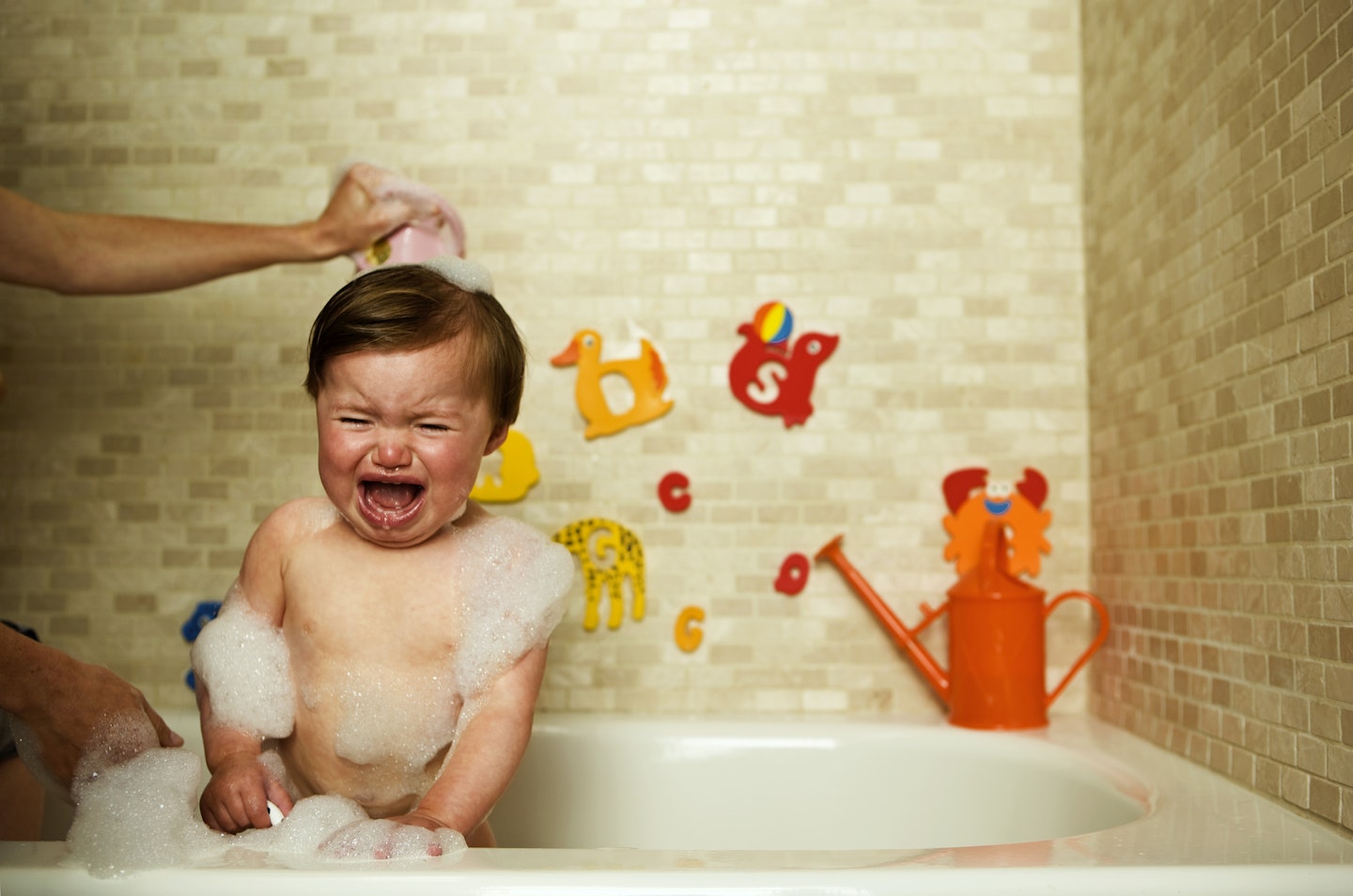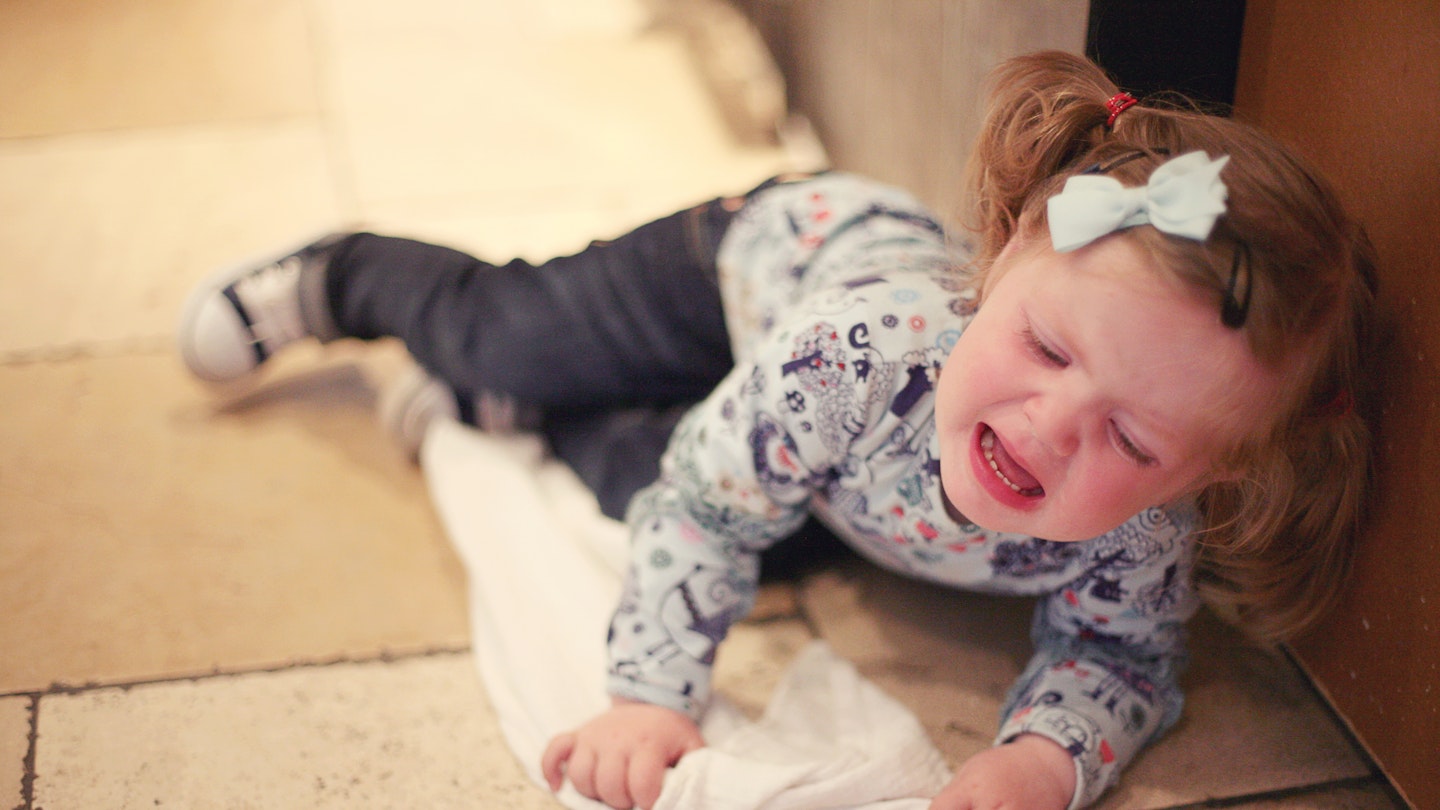Ever feel as though you could set your watch by your toddler’s tantrums? You’re not alone. But pinpoint his meltdown pattern, and it’s possible to sail through the day!
Meet the Expert: Rebecca Schrag Hershberg is a clinical psychologist, author of The Tantrum Survival Guide, and a mum of two; littlehousecalls.com.
Toddler tantrums. Not fun. But absolutely normal.
‘Tantrums are a response to the emotions that your child is feeling,’ says Rebecca. When he has a tantrum it is always because he’s dealing with an emotion that he just can’t handle yet. ‘And, let’s face it, we all have moments when we feel overloaded by our emotions.’
Even as adults, there are moments when we lose it. And that’s despite having fully developed brains that help us to process and rationalise those feelings; and coping mechanisms like knowing how to breathe deeply to regulate our nervous system, or the ability to physically remove ourselves from a fraught interaction. ‘Toddlers don’t have these tools,’ says Rebecca. ‘Their brains are still developing, so they don’t have the reasoning or empathetic skills to help them understand the situation and their response to it. They don’t have the language to articulate what they’re experiencing, which heightens the frustration and fear that comes with feeling emotionally out-of-control. And they don’t have the freedom to remove themselves from the situations they’re in.’
So, when a toddler encounters a situation that makes him feel a strong emotion – whether that’s sadness, happiness, excitement, or fear – that emotion may quickly start to feel overwhelming. And when the overwhelm becomes too much: ping, It’s tantrum time!
‘That can happen at any time of day,’ says Rebecca, ‘but there are key points when your youngster is more likely to find everything too much. ‘I call these “high-demand” times: moments a child is being asked to do a lot in a short time.’
Being asked to do a lot is hard on its own. And it’s made harder by the fact that the toddler years are when youngsters start to push for autonomy. They’re biologically programmed to start pushing limits; saying ‘no’ and generally exerting their right to self-determine.
‘They already have a tendency to resist what you want them to do,’ says Rebecca. ‘Plus, they want to do things for themselves, while adults usually want youngsters to get tasks done to the adult’s schedule. And as kids have no concept of time, this conflict of interests can cause irritation on both sides.’
And, just to add fuel to the fire, that demand overload gets worse if your child is running low on other reserves: if he’s tired or hungry, or if he’s picking up on other people’s frazzled feelings.
‘It’s important to remember that tantrums don’t come out of the blue,’ says Rebecca. ‘They happen in response to what’s going on for your child – and what’s happening around him. But the good news is that are things that you can do to help your youngster (and yourself) sail through even the trickiest times of day.’
Here’s how...
Leaving the house
Why the drama?
‘Children usually have to leave the house because there is something that their grown-up wants (or has) to do,’ says Rebecca. ‘They need to leave for work or get to the shops. So, right away this situation carries the potential for a conflict of desires. Your toddler wants to stay in and play with his blocks, while you want to go out.’
And there’s another reason why this shift from the indoors out can cause a meltdown. ‘When adults leave the house, we do lots of things on auto-pilot,’ says Rebecca. ‘We put on our shoes and zip up our coats and grab what we need without having to really think about it. But, for toddlers, these aren’t auto-pilot actions, they’re challenging tasks. They need to think about each step and they want to do it for themselves.’

Each task takes time. Parents get frustrated. The toddler picks up on the frustration and gets upset... ‘Add into the mix children who dislike change or who are extra-sensitive to sensory experiences – changes in temperature or loud noises – and it starts to become clear why leaving the house can be a big operation,’ says Rebecca.
Plan ahead!
If you know you have to leave the house at a particular time, start the getting-ready process a good 15 minutes before you need to be out the door. That one, simple change will help reduce your stress about being late. And if you’re relaxed, your youngster is less likely to get worked up.
‘If you can go at your child’s pace (aka very slowly), without getting grumpy, it makes leaving the house much smoother,’ says Rebecca. ‘So, before trying to bundle him into his coat and rush him out of the door, ask yourself – do I really need to hurry? If you don’t, just remind yourself that when your child takes 10 minutes to put his shoes on (and then they’re on the wrong feet), it doesn’t matter! Bigger picture: he’s building his motor skills and you’re there to cheer him on.’
Play Are You Ready, Teddy?’
Toddlers love to do what you do – so use this to your advantage when you need to get out of the house. Buy a teddy with a little outfit – coat and shoes. Then, ask your toddler to get his teddy ready, while you’re getting him ready. So, while he’s pulling on teddy’s shoes, you get his onto his feet. Everyone’s ready, everyone’s happy!
Unleash your inner Ariana Grande
Singing makes any activity easier – because your toddler will enjoy it and it has a relaxing effect on you. Try taking nursery rhymes and changing the lyrics to suit the ‘going out’ vibe...
Twinkle, twinkle little shoes
Oh, how well they fit on you!
Down below your feet they sit
Round your toes and heels they slip
Twinkle, twinkle little shoes
Oh, they look so good on you!

Jump the doorstep
If your little one takes time to feel comfortable outside after being inside, help to ease the transition by jumping him over the doorstep. You go outside first, turn around, take his hands and see how high he can jump to get out. ‘That skin-to-skin contact helps to reassure him, while the jumping distracts him from the fact that he’s going outdoors,’ says Rebecca.
Play Softly, Softly, Shoes-on
Another way to distract your toddler into getting ready (and having fun while he does it) is to set him a challenge. ‘If I close my eyes, can you get your shoes on without me hearing you?’
Mealtimes
Why the drama?
First up, if it’s mealtime, your youngster is probably hungry. And, as anyone who’s ever been hangry knows, that in itself can cause a few moody moments. Second up, mealtimes involve a transition. Your child has to put down what he’s doing and sit at the table. You want him to. He may not feel the same way.
And, third up, for many parents, food can be a tricky issue.
‘How children eat can feel like a high-stakes activity’ says Rebecca. ‘We want our kids to be happy little eaters: to eat a well-balanced diet so they grow up fit and healthy. But children can be fussy about food.Their appetites fluctuate; some are reluctant to try new tastes and textures, and it can be frustrating for parents to see their efforts in the kitchen being rejected by a-making-his-feelings-known toddler. Plus, lots of parents have tricky relationships with food themselves. That makes it harder for them to remain neutral about their child’s approach to food.’
But when parents get annoyed, toddlers pick up on it – and then the feelings can escalate...
Give him a heads-up
‘Toddlers get very absorbed in whatever activity they’re doing,’ says Rebecca. ‘If he’s busy doing a jigsaw he may not notice you cooking or setting the table – or sitting at the table waiting for him.’ The answer is to take a couple of minutes while the food is cooking to go over to your toddler, get down to his level, make eye contact and tell him that after he puts in three more pieces of his jigsaw, it will be time for food.
‘Gently prep him that the transition is coming,’ says Rebecca. ‘And give him a concrete way to understand when that’s going to happen. He won’t understand “in a minute”, but he can understand “three more jigsaw pieces”.’

Look for help
If you can get your child involved in preparing for a meal, it will help him to be aware that the meal is happening and to feel more ownership over it. That can pay dividends in terms of getting him interested in sitting at the table and sharing a meal together. ‘Try saying, ‘Please would you be super-helpful and wipe the table?’ says Rebecca. ‘Or please would you be super-helpful and put this plate on the table?’ If he does, great! If he doesn’t, just let him make that choice.
Make him king of the plate
You’ve decided what to cook for your child. Let him decide what to eat. ‘Only he knows how hungry he feels,’ says Rebecca. ‘Take the pressure off yourself and let him choose what to eat. That means you won’t get anxious about his eating; he’s more likely to enjoy his meals, and tantrums will be averted!’
Ask a surprise question
If it looks like trouble’s brewing, defuse the situation by asking your youngster, ‘Can you remember what we had for lunch yesterday?’ Because he has to think about it, he’ll (hopefully) forget what was making him cross and focus on the answer. And when he remembers that it was pasta – ask him a question about the pasta. ‘What shape pasta do you like best?’ ‘Does the Queen like flat pasta or curly pasta?’ ‘What does the Queen like putting on her pasta?’
Turn the tables
Your child doesn’t want to eat. No problem! Ask him to feed you. ‘Giving him that control will surprise him, hopefully make him smile, and gives you an opportunity to model good eating by enjoying the forkful he delivers into your mouth!’
The 5pm grizzle
Why the drama?
Two key tantrum triggers at this time of day are tiredness and hunger. ‘But there’s another reason for the 5pm doldrums,’ says Rebecca. ‘Lots of toddlers have been at nursery or with a childminder during the day, while parents are at work. So, 5pm is a time for re-uniting. But when they see you again – toddlers become aware of having missed you.’
That can provoke tears. But your reserves may be low too. It’s the end of the day, you need to get home; you’re tired from work, there’s still a lot to do and you may feel guilty or upset that your youngster is crying.
‘It’s easy for parents to find themselves in a situation where they’re hurrying to get back to start the evening routine, while their toddler is working themselves into a tizz,’ says Rebecca. ‘Then everyone winds up feeling on edge.’
Take five
If you feel grounded and ‘in-the-moment’ when you pick up your child, he’ll respond to the fact that you are calm. So, shake off any work stresses by taking three deep breaths and then focusing on the present moment by thinking about five things you can see; four things you can touch; three things you can hear; two things you can smell and one thing you can taste.
Reconnect with him
When you haven’t seen your child for a few hours, take time for a big hug and a ‘chat’. Don’t bundle him into the back of the car and drive off. Spend a couple of minutes making eye contact, talking to him, cuddling him. ‘Those few minutes of focused attention show your child that you’re delighted to see him,’ says Rebecca. ‘You’re giving him attention without him having to ask for it; reconnecting, and making that transition back to “family time” easy.’
Sing!
Singing together = instant connection. Try, If you’re happy and you know it all the way home!
Put on a funny voice
A glove puppet that can talk to your child and mirror his feelings is really handy at the end of a long day. You can use the puppet to ask your child questions in a funny voice. ‘I’m cold, are you?’ ‘What can I do to get warm?’ ‘Shall I jump up and down?’ ‘Shall I rub my arms?’ ‘Shall I tell you a story about a big, hot, potato?’
Don’t forget a snack!
Sometimes a healthy snackat the right time is all it takes to avoid a meltdown. Raisins really can save the day!
Bathtime
Why the drama?
As lovely as the idea of a pre-bedtime bathmay be, there are a whole number of reasons why it can be problematic. For example...
-
Both you and your youngster are tired.
-
The bathroom can be a very different environment to the rest of the house: the temperature, the toys and the acoustics all make it a unique space. That makes it stimulating for youngsters – who can then get overtired in that environment.
-
Bathtime involves a double transition – going into the bath and getting out. Double the change: double the chances for fussing.
-
Some toddlers dislike baths. That, plus tiredness, is a recipe for a meltdown.
-
As well as the bath itself, you then have to dry your child, dry their hair and get them into pyjamas.
-
You are on a schedule – making sure that bath is done in time for bedtime – while your child is not.
Have a timer

Get a timer where your child can see the time counting down, set it, and explain that when the timer goes to the beginning, a bell will sound and that’s time to get out of the bath. ‘This is a visible and audible cue that helps your child understand what’s going to happen,’ says Rebecca. ‘That’s reassuring because he understands what’s going on. Plus, the timer’s telling him to get out of the bath, not you, so it reduces his urge to assert his autonomy and refuse to leave the water.’
Pick a towel!
When you give your child choices, you’re giving him the autonomy he wants. So, which towel does he want – the red fluffy one or the big blue one? Which shampoo does he want – the yummy strawberry one or the delicious orange one? Who should pull the plug: you or him?
Avoid a bedroom stop
If you’re having a bath after dinner, go straight to the bathroom. Avoid the bedroom (or the playroom... or any other room). Why? Because, if you go somewhere else before the bath, you’re creating another transition for your child to deal with. So, straight to the bathroom, and clothes off in there while the bath is running.
Say bye-bye bath!
One of the best ways to avoid a tantrum is to recognise and acknowledge how your child is feeling. So, if he’s sad about getting out of the bath, voice that feeling. ‘I know you’re sad about getting out of the warm bath. It’s hard when the air feels cold. The bath is sad too. Let’s wave bye-bye to the bath. Bye-bye bath – we’ll see you again soon! Hello towel, you feel snuggly and warm.’
Create a picture guide
Draw pictures of what happens at bathtime, in order. That acts as a reassuring visual reminder, showing your youngster what will happen. You could start with doing teeth; then running the bath; testing the temperature; getting wet hair; having a funny shampoo hairstyle; washing off the shampoo; pulling the plug; snuggling in the towel.
Bedtime
Why the drama?
Apart from the (obvious) tiredness that’s hitting everyone by evening, bedtime is a big transition moment for youngsters. ‘The bedtime routine is actually the precursor to the biggest period of separation between you and your child – the night. A common scenario is that your child isn’t ready to separate and tries to get more time to connect with you. But, because you’re tired and want a bit of adult time before you have to go to bed, too, you get annoyed with his attempts to keep you with him. He senses your annoyance and becomes anxious... and the relaxing bedtime routine derails.’
Relax your tongue

Thoughts of everything you need to do before you can go to bed bothering you? Banish them by focusing on one simple task: relaxing your tongue. This is surprisingly hard to do...but the upside is that it takes so much focus it clears away the other annoying things buzzing around in your brain.
Treat yourself
This 20-minute period before bed doesn’t just have to be soothing for your toddler – it can be soothing for you, too. Make sure you’ve got a comfy chair to sit in (with your toddler on your lap); dim the lights; put on some gentle background music; and spritz some calming lavender into the air. Then... enjoy!
Stick to the routine
Children feel happiest when they understand what’s happening and why it’s happening – so the fastest way to help your little one relax and avoid meltdowns is just to stick to your usual bedtime routine.
List three happy moments
When your child feels the bond between you, it helps him to handle the nighttime transition without getting overwhelmed. So, as part of your bedtime routine, list three happy moments that you shared during the day or three times you thought about him and it made you happy. Try and make these memories as specific as possible. ‘I was really happy when we were standing by the tall brick wall watching the snail with the green shell. Thank you for showing me the little hole at the entrance to his house. Shall we look for him tomorrow?’
Be empathetic
If your child is saying he doesn’t like bedtime, engage with what he’s saying and show that you’ve heard. ‘It can be hard to go to bed when you want to play with your dinosaurs. You want to build a dinosaur den. You can do that tomorrow, darling. It’s bedtime now.’ That acknowledges his feelings, without giving in to them – and your youngster will feel reassured that you understand him, which builds the connection between you and helps him to go to sleep happily.
‘Tantrums are a normal part of toddler development,’ says Rebecca. ‘They’re a way of teaching your toddler to experience and then understand his feelings. And understanding his feelings – and recognising at what points in the day he might be feeling a certain way – is a vital step in helping him to navigate the world and express what he needs.’
Read next on Mother&Baby:
-
7 things to tell yourself when your toddler is having a tantrum
-
How to keep your toddler entertained during the weekly food shop
What are your toddler tantrum tips? Let us know on Twitter! And while you're there, follow us on Instagram and Facebooktoo!
Why not join thousands of mums and start your very own Amazon Baby Wish List? It's easier than you might think!
